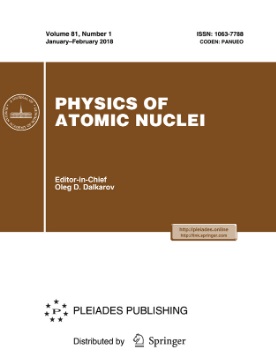 Study of the Involvement of 8Be and 9B Nuclei in the Dissociation of Relativistic 10C, 10B, and 12C Nuclei
Study of the Involvement of 8Be and 9B Nuclei in the Dissociation of Relativistic 10C, 10B, and 12C NucleiDOI: 10.1134/S1063778817060047
D.A. Artemenkov, V. Bradnova, G.I. Britvich, etc.
7 P.
Physics of Atomic Nuclei, 2017, Vol. 80, No. 6, pp. 1126–1132.
The results obtained by estimating the contribution of  and
and  nuclei to the coherent
dissociation of
nuclei to the coherent
dissociation of  ,
,  , and
, and  relativistic nuclei in nuclear track emulsions (“white” stars) are presented.
The selection of white stars accompanied by
relativistic nuclei in nuclear track emulsions (“white” stars) are presented.
The selection of white stars accompanied by  leads to a distinct peak appearing in the distribution of the
excitation energy of
leads to a distinct peak appearing in the distribution of the
excitation energy of  ensembles and having a maximum at
ensembles and having a maximum at  MeV.
A
MeV.
A  nucleus manifests
itself in the coherent-dissociation reaction
nucleus manifests
itself in the coherent-dissociation reaction  with a probability of
with a probability of  %,
%,  % of
it being due to
% of
it being due to  decays. The ratio of the branching fractions of the
decays. The ratio of the branching fractions of the  and
and  mirror channels
is estimated at
mirror channels
is estimated at  . An analysis of the relativistic dissociation of
. An analysis of the relativistic dissociation of  nuclei in a nuclear track emulsion
revealed nine
nuclei in a nuclear track emulsion
revealed nine  events corresponding to the Hoyle state.
events corresponding to the Hoyle state.



